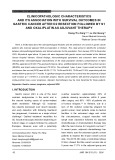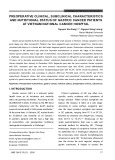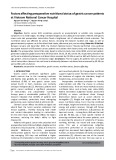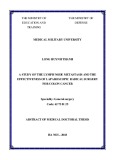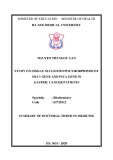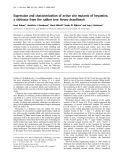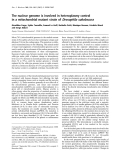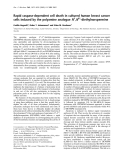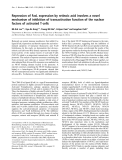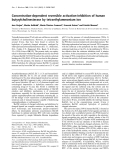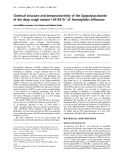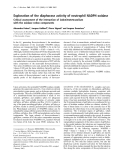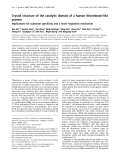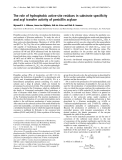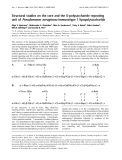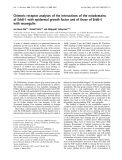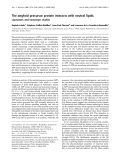
HUE JOURNAL OF MEDICINE AND PHARMACY ISSN 3030-4318; eISSN: 3030-4326 53
Hue Journal of Medicine and Pharmacy, Volume 14, No.4/2024
Prognostic value of mismatch repair protein expression in unresectable
gastric cancer
Nguyen Thi Hong Chuyen1, Nguyen Thi Thu Giang1, Nguyen Tran Bao Song1,
Ngo Quy Tran1, Dang Cong Thuan1*
(1) Hue University of Medicine and Pharmacy, Hue University
Abstract
Background: Gastric cancer (GC) is one of the common types of cancer in Vietnam. Over 50% of GCs are
diagnosed at an unresectable stage. Deficiency in mismatch repair proteins (MMR) leading to microsatellite
instability (MSI-H) is a crucial prognostic factor currently under investigation in these patients. Therefore, this
study aimed to determine the rate of MMR protein expression and its correlation with clinical characteristics,
histopathological features, and overall survival in unresectable GC patients. Materials and methods: A
descriptive case series study on 83 GC patients at unresectable stage, treated at Hue University of Medicine
and Pharmacy Hospital and Hue Central Hospital from June 2020 to December 2022. Immunohistochemical
staining was utilized to assess MMR protein expression. A deficiency in any MMR protein was considered as
deficient mismatch repair proteins (dMMR). Conversely, the expression of all four MMR proteins in tumor
cells was defined as proficient mismatch repair proteins (pMMR). Result: The dMMR rate was 10.8% and
correlated with tumor size > 5 cm (p = 0.026) and well-differentiated tumors (p = 0.012). There was no
association between MMR protein expression and tumor location, lymph node metastasis, or histological
subtype. The dMMR group showed a significantly improved overall survival compared to the pMMR group, with
a median overall survival of 19.1 ± 1.8 months compared to 9.3 ± 0.8 months (p = 0.02). Conclusions: There are
correlation between MMR protein deficiency and tumor size and differentiation. dMMR GC patients have a
better prognosis compared to those with pMMR.
Keywords: gastric cancer, mismatch repair protein deficiency, immunohistochemistry.
1. INTRODUCTION
In Vietnam, gastric cancer is one of the most
common cancers with the third highest mortality
rate [1]. Over 50% of GC patients are diagnosed at an
unresectable stage. In these patients, overall survival
is typically 10-12 months, with a 5-year survival rate
of less than 10% [2 - 5]. Currently, numerous studies
worldwide have shown that overall survival and
treatment response of patients are not only related
to cancer stage but also to molecular biological
characteristics of tumors, especially microsatellite
instability (MSI-H). MSI-H is caused by a deficiency in
mismatch repair proteins (dMMR), including MLH1,
PMS2, MSH2, and MSH6, which can be detected by
immunohistochemistry with a sensitivity of 91.1%
and a specificity of 98.5% [6,7]. MSI-H can occur in
Lynch syndrome or sporadic gastric cancer due to
non-heritable changes such as methylation of MMR
regulatory genes. The correlation between deficient
MMR and clinical-pathological factors including
older age, distal location of the tumor, histological
subtype, fewer lymph node metastases, stage, and
overall survival has been reported. Authors Polom
K (2018) and Giampieri R. (2015) both identified
dMMR as an independent prognostic factor in
unresectable gastric cancer patients [4,8]. Patients
with dMMR gastric cancer have better overall
survival compared to the pMMR group. In Vietnam,
the overall survival of unresectable gastric cancer
patients is only about 11 months [9, 10]. Therefore,
we conducted this study with two objectives: (1) To
evaluate MMR protein expression in unresectable
gastric cancer patients, and (2) To analyze the
correlation between MMR protein expression status
with various clinical, paraclinical, and overall survival
in unresectable gastric cancer.
2. MATERIALS AND METHODS
2.1. Study design:
We conducted a descriptive case series study, a
combination of prospective and retrospective cohorts
on 83 patients diagnosed with unresectable gastric
cancer by histopathological through endoscopy
biopsy at at Hue University of Medicine and Pharmacy
Hospital and Hue Central Hospital from June 2020 to
December 2022. Patients had sufficient archived tissue
for immunohistochemical testing, complete medical
records, and follow-up information.
Corresponding author: Dang Cong Thuan; Email: dcthuan@huemed-univ.edu.vn
Received: 8/4/2024; Accepted: 15/6/2024; Published: 25/6/2024
DOI: 10.34071/jmp.2024.4.7





